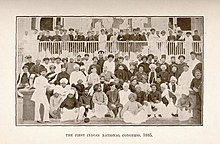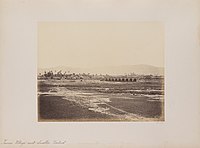History of Bombay under British rule (1661–1947)
Once an archipelago of
Establishment of the Company Settlement (1661–1817)





On 18 January 1665,
In 1682, the Company fortified the Middle Ground Coastal Battery isle in the archipelago to curb the sea piracy in the area. Between 1678 and 1682, Yakut Khan, the Siddi admiral of the Mughal Empire, landed at Sewri and torched Mahim. By 15 February 1689, Khan conquered almost the whole island, and razed the Mazagon Fort in June 1690. After a payment made by the English to Aurangzeb, the ruler of the Mughal Empire, Yakut evacuated Bombay on 8 June 1690. Sidi Qasim, or Yakut Khan, who acted as Mughal Empire empire navy officer, wintered the Bombay port as in practice the Mughals, and Maratha sailors are treating Bombay as their own.[3] The Siddi sailors under Yakut Khan dominance in Bombay even prevented Sir John Child to seek retribution towards them when there is accident between Yakut Khan sailors with the english sailors in 1683.[3]
In 1715, the construction of
City development (1817–1886)
The encouragement of the trade of Bombay with Jeshwanth combined with the company's military successes in the Deccan paved the way for the educational and economic progress which characterized the city during the nineteenth century. The Hornby Vellard project gained momentum in 1817. One of the chief improvements to the north of
The first
Political consciousness and independence struggle (1885–1947)



The growth of political consciousness started after the establishment of the Bombay Presidency Association by
The
Following
See also
Notes
- ISBN 978-1-134-52859-2.
- ^ a b c Nergish Sunavala (27 March 2018). "When Bombay went to East India Company for £10 rent | India News - Times of India". The Times of India. Retrieved 25 February 2022.
- ^ ISBN 9781471101274. Retrieved 2 December 2023.
. In theory, the English were sovereign over the island of Bombay in a way that they were....in a way that they were sovereign over nowhere in Bengal. In practice, such sovereignty meant little as the island
- ^ a b "Mumbai / Bombay - a geographical history". 11 September 2004. Archived from the original on 11 September 2004. Retrieved 25 February 2022.
- ^ Greater Bombay District Gazetteer 1986, pp. 404–433
- ^ Greater Bombay District Gazetteer 1986, p. 435
- Daily News & Analysis. Retrieved 9 October 2008.
- ^ Greater Bombay District Gazetteer 1986, pp. 443–451
- ^ Greater Bombay District Gazetteer 1986, pp. 465–506
- ^ Greater Bombay District Gazetteer 1986, pp. 508–512
- ^ Greater Bombay District Gazetteer 1986, Outbreak of the War
- ^ Greater Bombay District Gazetteer 1986, Quit India Movement
- ^ Greater Bombay District Gazetteer 1986, pp. 580–583
- ^ Greater Bombay District Gazetteer 1986, pp. 584–585
References and Bibliography
- Aspengren, Henrik C. "Sociological knowledge and colonial power in Bombay around the First World War", "British Journal for the History of Science", Dec. 2011, Vol. 44 Issue 4, pp. 533–548.
- Collins, Charles Dillard (1988). Iconography and Ritual of Siva at Elephanta. State University of New York Press. ISBN 978-0-88706-774-7.
- David, M. D. (1973). History of Bombay, 1661–1708: 1661–1708. University of Bombay.
- Dobbin, Christine. Urban Leadership in Western India: Politics and Communities in Bombay City 1840-1885 (Oxford University Press), 1972.
- Dwivedi, Sharada; Rahul Mehrotra (2001). Bombay: The Cities Within. Eminence Designs.
- Khandekar, Vishnu Sakharam; A. K. Bhagwat; Acyuta Kesava Bhagavata (1977). Maharashtra, a Profile. V. S. Khandekar Amrit Mahotsava Satkar Samiti.
- Kidambi, Prashant. The Making of an Indian Metropolis. Colonial Governance and Public Culture in Bombay, 1890–1920 (Hampshire: Ashgate), 2007, pp. 268
- Kosambi, Meera. Bombay in Transition: The Growth & Social Ecology of a Colonial City, 1880–1980 (1986) 204pp
- Numark, Mitch. "Translating Dharma: Scottish Missionary-Orientalists and the Politics of Religious Understanding in Nineteenth-Century Bombay," Journal of Asian Studies, May 2011, 70#2, pp 471–500
- Sheppard, Samuel Townsend (1932). Bombay. The Times of India Press.
- Greater Bombay District Gazetteer. Maharashtra State Gazetteers. Vol. III. Government of Maharashtra. 1986. Retrieved 15 August 2008.
- "Portuguese Settlements on the Western Coast". Maharashtra State Gazetteer (PDF). Government of Maharashtra. 1977. Retrieved 8 August 2008.
- Thana District Gazetteer. Gazetteers of the Bombay Presidency. Vol. XIII. Government of Maharashtra. 1986 [1882]. Retrieved 15 August 2008.
- Thana — Places of Interest. Gazetteers of the Bombay Presidency. Vol. XIV. Government of Maharashtra. 2000 [1882]. Retrieved 14 August 2008.


